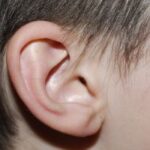At every single one of my children’s pediatrician’s appointments, the doctor always say “there sure is a lot of wax in there.” If the boys are feeling all right, the doctor will usually just comment and then move on. However, as is often the case, we are in the office for a suspected ear infection and the doctor has to use a curette to get a clear look at his ear drum.
A curette is a thin, spoon-shaped instrument with that is held like a pencil and used to scoop out the wax. The pediatrician will gently remove bits of wax from the ear until he or she can get a full glimpse of the ear drum to assess if the child has an ear infection or not.
While this wax removal is not painful, the younger the child, the more difficult this technique is to perform. My toddler is just reaching the age where it is not necessary to bodily restrain him during the wax removal; for the baby it is a physically exhausting and emotionally taxing procedure for everyone involved.
So what is ear wax?
Earwax is one of those substances that only a parent could obsess over. The outer third of the ear canal’s lining produces ear wax. Earwax is actually the body’s way of protecting the eardrum and lining of the ear canal. It keeps dust off of the eardrum and protect the ear canal lining.
Ear wax color varies from light yellow to dark brown, the color differs for every individual. Since the ear canal is designed to clean itself, ear wax forms every day and usually falls out on its own.
Earwax removal techniques
Most pediatricians are in agreement that unless the ear is blocked and hearing is impaired, the best earwax treatment is leaving it alone. When individuals try to remove the wax from the inside of the ear, at least some of the wax usually gets pushed back into the ear canal and it becomes more difficult for the wax to come out naturally. According to information published by the C.S. Mott Children’s Hospital at the University of Michigan, wax build up does not cause ear infections but excessive build up can eventually limit hearing capacity. In these instances, or when a doctor needs a clear view of the eardrum, removing earwax is necessary.
Contrary to popular belief, you should never use a cotton-tip swab to clean a child’s ears or remove wax. This technique only packs the earwax deeper into the ear canal, where it’s difficult to remove and where a deep swipe could puncture an eardrum.
One way to clean your child’s ears is to wipe the outside of each ear with a warm washcloth. This will remove any newly formed wax in a safe manner.
Debrox drops are another technique for breaking down earwax. The drops soften the earwax enough for it to naturally drain out of the ear or with assistance from a gentle warm water flush. However, Debrox drops are not recommended or practical for young children, and should only be used after consulting a pediatrician.
If your child tends to have a lot of earwax, place a few drops of mineral or baby oil in the ear before bedtime. This method usually softens and cleans out the wax enough for it to drain out or for a pediatrician to get a full glimpse of the ear drum or have an easier time using the curette or warm water flush.
Everyone has earwax, how much depends on genetics. Unless your child is experiencing ear aches or hearing loss, earwax is best left alone or removed only by a pediatrician.





